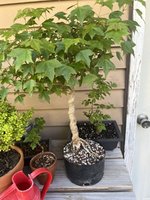On this first picture is that corkscrew from leaving wire and allowing to grow around it? Just wondering as when I went to local club last month a seasoned bonsai guy recommended this technique to thicken trunk but mostly have seen to avoid this. Just wonderingHey everyone. I wanted to share some pictures of my little garden, mostly things in development - long way to go.
View attachment 543522
View attachment 543523
View attachment 543524
View attachment 543525
View attachment 543526
View attachment 543527
View attachment 543528
View attachment 543529
View attachment 543530

On this first picture is that corkscrew from leaving wire and allowing to grow around it? Just wondering as when I went to local club last month a seasoned bonsai guy recommended this technique to thicken trunk but mostly have seen to avoid this. Just wondering
Yes, that corkscrew is from leaving wire on, what have you heard as far as negative effects?On this first picture is that corkscrew from leaving wire and allowing to grow around it? Just wondering as when I went to local club last month a seasoned bonsai guy recommended this technique to thicken trunk but mostly have seen to avoid this. Just wondering
Well really only wire marks in general but the one that mentioned doing it said eventually it grows around and completely hides it. Although I would think cutting along trunk would do some damage to cutters. Also wonder how well taper on trunk would be produced on a deciduous tree without trunk chopping and just having single trunk with wire for thickening?Yes, that corkscrew is from leaving wire on, what have you heard as far as negative effects?
Always good information @Shibui. Thanks for sharing. I was surprised to hear this as a good thing to try and did not plan to use it myself. The guy also mentioned for root over rock using multiple seedlings with the trunks as the “roots” that go over rock and go ahead amd bury true roots in soil. The trees are then supported to fuse together at top to make a single trunk. Was interesting but not what I have seen done here on bnut.Wire marks seem to disappear quicker where bark is rough and thicker like pines but marks stand out for many years on smooth barked trees like your trident. If you like the look feel free to use it but I don't think it looks natural. I'd rather have a trunk with more natural scarring or none at all.
It is possible to use this to thicken deciduous trunks but I've found the failure rate is quite high. I've needed a lot of thickening after to get the marks to heal properly and quite a few just don't seem to heal properly. All in all I'd advise other methods to get increased trunk thickening and taper.
If you decide to try it wire MUST start right down at root level or you get very bad inverse taper below the start of the wire.
I've attempted many trunk fusion projects. The results have not been as advertised. I've only kept 1 out of maybe 20 or 30 attempts. Maybe someone can learn all the pitfalls and work out ways to avoid them. Maybe someone can just be lucky. My experience is it is quicker and easier to grow on a single trunk than to fuse trunks and end up with a good trunk.The guy also mentioned for root over rock using multiple seedlings with the trunks as the “roots” that go over rock and go ahead amd bury true roots in soil. The trees are then supported to fuse together at top to make a single trunk. Was interesting but not what I have seen done here on bnut.
There are a great many more theories than actual practice in bonsai. Many people have read many theories and lots of those people will feel the need recommend on the basis of something they've read rather than something they've done. Ask such people have they actually done it?The guy also mentioned
